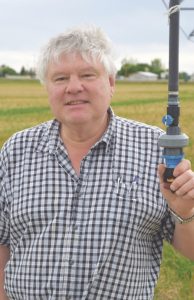Flexibility but no added yield for fertigation
KEY RESULT:
This study compared nitrogen application through side-banding at seeding and through a split application of side-banding at seeding plus in-season through an irrigation system. It found no yield advantage to the split, but the flexibility of fertigation (for those with irrigation systems) allows farmers to adjust rates based on conditions through the season.
PROJECT TITLE, PRINCIPAL INVESTIGATOR:
“Evaluation of sap nitrate for
in-season assessment of crop nitrogen status,”
Dale Tomasiewicz, AAFC Outlook, Saskatchewan
FUNDING:
Canadian Agricultural Partnership

Delaying application of a portion of the crop’s fertilizer nitrogen provides an opportunity to assess the crop’s nitrogen status in-season to better match fertilization to crop needs. This study (1) compared various in-season plant analysis tests for N, including a sap test, and (2) compared in-season nitrogen top up with fertigation compared to applying all nitrogen in a side-band at the time of seeding.
Sap test
Researchers evaluated effectiveness of various plant tissue testing technologies and plant reflectance (NDVI) as in-season indicators for the need to supply additional nitrogen to crops that are becoming deficient. Most tests require submission of samples to a laboratory – which is not ideal in-season due to the additional work required and the delay before results are received.
Sap nitrate tests can be conducted quickly on-site using canola petioles (leaf stems). These are easily sampled and high in moisture, so the sap can be easily expressed. Two methods of measurement of nitrate in the sap were assessed. Both are quick to use and relatively inexpensive (on a per-sample basis). The plant nitrate tests (including sap tests) were found to provide a better basis for indicating the need to apply additional nitrogen for optimum yield, as compared to tests for tissue total nitrogen or canopy NDVI. Tests taken at the bolting stage generally provided a much better indicator of the need for additional nitrogen than those taken at the earlier (five- to six-leaf) stage. With fertigation (or timely rainfall), nitrogen application at the bolting stage is early enough to provide for a substantial portion of canola nitrogen requirement.
Fertigation
The capability to apply fertilizer through an irrigation system (or “fertigate”) can offer producers the means to maximize their nitrogen use efficiency by more closely matching the timing of nutrient application to crop needs. It also avoids the added cost of enhanced efficiency fertilizer products, which are often suggested to reduce losses of spring-applied nitrogen, and the extra field operation and crop damage associated with in-season fertilizer application.
For fertigation, urea-ammonium nitrate 28-0-0 was injected into the irrigation line. Fertigation nitrogen applications were made in irrigation events with 0.5 inch of irrigation water. Plots not receiving fertigation were also irrigated.
Results show that canola yields were strongly related to total nitrogen applied – no matter the method used.
In contrast, the nitrogen application method and timing had little impact on canola yield. The option to delay a portion of the nitrogen application through fertigation can increase flexibility of nitrogen fertilizer application timing, but this practice did not provide any incremental benefit to canola yield or quality under the study conditions. Soil and weather conditions were not conducive to in-season loss of applied nitrogen through leaching in the study.
Emissions of the greenhouse gas nitrous oxide (N2O) were affected more by the total amount of fertilizer nitrogen applied than by which method was used to apply it. Total seasonal emissions of N2O were generally low, well under one kilogram of N2O-N per hectare, in all monitored treatments in all years.





